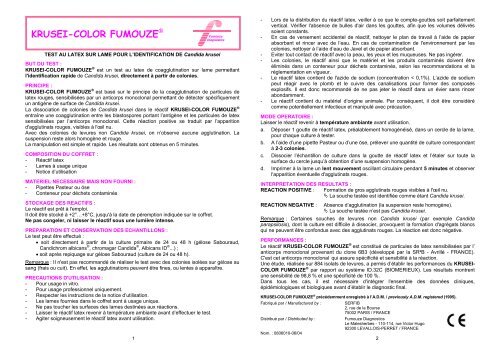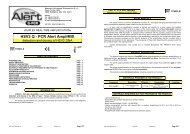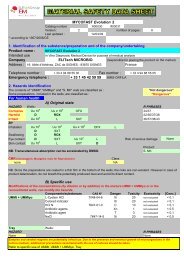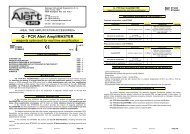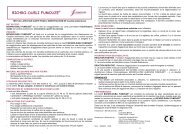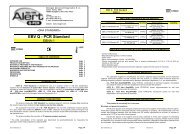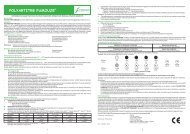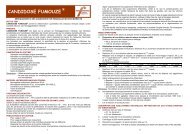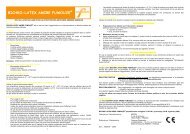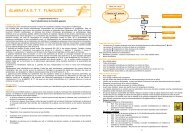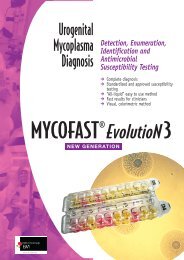KRUSEI-COLOR FUMOUZE®
KRUSEI-COLOR FUMOUZE®
KRUSEI-COLOR FUMOUZE®
Create successful ePaper yourself
Turn your PDF publications into a flip-book with our unique Google optimized e-Paper software.
<strong>KRUSEI</strong>-<strong>COLOR</strong> FUMOUZE ®<br />
TEST AU LATEX SUR LAME POUR L’IDENTIFICATION DE Candida krusei<br />
BUT DU TEST :<br />
<strong>KRUSEI</strong>-<strong>COLOR</strong> FUMOUZE ® est un test au latex de coagglutination sur lame permettant<br />
l'identification rapide de Candida krusei, directement à partir de colonies.<br />
PRINCIPE :<br />
<strong>KRUSEI</strong>-<strong>COLOR</strong> FUMOUZE ® est basé sur le principe de la coagglutination de particules de<br />
latex rouges, sensibilisées par un anticorps monoclonal permettant de détecter spécifiquement<br />
un antigène de surface de Candida krusei.<br />
La dissociation de colonies de Candida krusei dans le réactif <strong>KRUSEI</strong>-<strong>COLOR</strong> FUMOUZE ®<br />
entraîne une coagglutination entre les blastospores portant l’antigène et les particules de latex<br />
sensibilisées par l’anticorps monoclonal. Cette réaction positive se traduit par l’apparition<br />
d'agglutinats rouges, visibles à l'œil nu.<br />
Avec des colonies de levures non Candida krusei, on n’observe aucune agglutination. La<br />
suspension reste alors homogène et rouge.<br />
La manipulation est simple et rapide. Les résultats sont obtenus en 5 minutes.<br />
COMPOSITION DU COFFRET :<br />
- Réactif latex<br />
- Lames à usage unique<br />
- Notice d’utilisation<br />
MATERIEL NECESSAIRE MAIS NON FOURNI :<br />
- Pipettes Pasteur ou öse<br />
- Conteneur pour déchets contaminés<br />
STOCKAGE DES REACTIFS :<br />
Le réactif est prêt à l'emploi.<br />
Il doit être stocké à +2°…+8°C, jusqu'à la date de péremption indiquée sur le coffret.<br />
Ne pas congeler, ni laisser le réactif sous une lumière intense.<br />
PREPARATION ET CONSERVATION DES ECHANTILLONS :<br />
Le test peut être effectué :<br />
• soit directement à partir de la culture primaire de 24 ou 48 h (gélose Sabouraud,<br />
Candichrom albicans ® , chromagar Candida ® , Albicans ID ® ...) ;<br />
• soit après repiquage sur gélose Sabouraud (culture de 24 ou 48 h).<br />
Remarque : II n'est pas recommandé de réaliser le test avec des colonies isolées sur gélose au<br />
sang (frais ou cuit). En effet, les agglutinations peuvent être fines, ou lentes à apparaître.<br />
PRECAUTIONS D'UTILISATION :<br />
- Pour usage in vitro.<br />
- Pour usage professionnel uniquement.<br />
- Respecter les instructions de la notice d’utilisation.<br />
- Les lames fournies dans le coffret sont à usage unique.<br />
- Ne pas toucher les surfaces des lames destinées aux réactions.<br />
- Laisser le réactif latex revenir à température ambiante avant d’effectuer le test.<br />
- Agiter soigneusement le réactif latex avant utilisation.<br />
Fumouze<br />
Diagnostics<br />
- Lors de la distribution du réactif latex, veiller à ce que le compte-gouttes soit parfaitement<br />
vertical. Vérifier l'absence de bulles d'air dans les gouttes, afin que les volumes délivrés<br />
soient constants.<br />
- En cas de versement accidentel de réactif, nettoyer le plan de travail à l’aide de papier<br />
absorbant et rincer avec de l’eau. En cas de contamination de l'environnement par les<br />
colonies, nettoyer à l’aide d’eau de Javel et de papier absorbant.<br />
- Eviter tout contact de réactif avec la peau, les yeux et les muqueuses. Ne pas ingérer.<br />
- Les colonies, le réactif ainsi que le matériel et les produits contaminés doivent être<br />
éliminés dans un conteneur pour déchets contaminés, selon les recommandations et la<br />
réglementation en vigueur.<br />
- Le réactif latex contient de l'azide de sodium (concentration < 0,1%). L’azide de sodium<br />
peut réagir avec le plomb et le cuivre des canalisations pour former des composés<br />
explosifs. Il est donc recommandé de ne pas jeter le réactif dans un évier sans rincer<br />
abondamment.<br />
- Le réactif contient du matériel d’origine animale. Par conséquent, il doit être considéré<br />
comme potentiellement infectieux et manipulé avec précaution.<br />
MODE OPERATOIRE :<br />
Laisser le réactif revenir à température ambiante avant utilisation.<br />
a. Déposer 1 goutte de réactif latex, préalablement homogénéisé, dans un cercle de la lame,<br />
pour chaque culture à tester.<br />
b. A l’aide d’une pipette Pasteur ou d’une öse, prélever une quantité de culture correspondant<br />
à 2-3 colonies.<br />
c. Dissocier l’échantillon de culture dans la goutte de réactif latex et l’étaler sur toute la<br />
surface du cercle jusqu’à obtention d’une suspension homogène.<br />
d. Imprimer à la lame un lent mouvement oscillant circulaire pendant 5 minutes et observer<br />
l'apparition éventuelle d'agglutinats rouges.<br />
INTERPRETATION DES RESULTATS :<br />
REACTION POSITIVE : Formation de gros agglutinats rouges visibles à l'œil nu.<br />
La souche testée est identifiée comme étant Candida krusei.<br />
REACTION NEGATIVE : Absence d’agglutination (la suspension reste homogène).<br />
La souche testée n’est pas Candida krusei.<br />
Remarque : Certaines souches de levures non Candida krusei (par exemple Candida<br />
parapsilosis), dont la culture est difficile à dissocier, provoquent la formation d'agrégats blancs<br />
qui ne peuvent être confondus avec des agglutinats rouges. La réaction est donc négative.<br />
PERFORMANCES :<br />
Le réactif <strong>KRUSEI</strong>-<strong>COLOR</strong> FUMOUZE ® est constitué de particules de latex sensibilisées par l’<br />
anticorps monoclonal provenant du clone 6B3 (développé par la SR²B - Avrillé - FRANCE).<br />
C'est cet anticorps monoclonal qui assure spécificité et sensibilité à la réaction.<br />
Une étude, réalisée sur 884 isolats de levures, a permis d’établir les performances du <strong>KRUSEI</strong>-<br />
<strong>COLOR</strong> FUMOUZE ® par rapport au système ID.32C (BIOMERIEUX). Les résultats montrent<br />
une sensibilité de 98,8 % et une spécificité de 100 %.<br />
Dans tous les cas, il est nécessaire d'intégrer l'ensemble des données cliniques,<br />
épidémiologiques et biologiques avant d’établir le diagnostic final.<br />
<strong>KRUSEI</strong>-<strong>COLOR</strong> FUMOUZE ® précédemment enregistré à l’A.D.M. / previously A.D.M. registered (1995).<br />
Fabriqué par / Manufactured by :<br />
SERFIB<br />
2, rue de la Bourse<br />
75002 PARIS / FRANCE<br />
Distribué par / Distributed by :<br />
Fumouze Diagnostics<br />
Le Malesherbes - 110-114, rue Victor Hugo<br />
92300 LEVALLOIS-PERRET / FRANCE<br />
Nom. : 0806010-06/04<br />
1 2
<strong>KRUSEI</strong>-<strong>COLOR</strong> FUMOUZE ®<br />
LATEX SLIDE TEST FOR THE IDENTIFICATION OF Candida krusei<br />
INTENDED USE :<br />
<strong>KRUSEI</strong>-<strong>COLOR</strong> FUMOUZE ® is a latex coagglutination slide test for the rapid identification of<br />
Candida krusei colonies, directly from cultures.<br />
PRINCIPLE :<br />
<strong>KRUSEI</strong>-<strong>COLOR</strong> FUMOUZE ® is based on the coagglutination principle of polystyrene particles,<br />
coated with a monoclonal antibody, which allows the specific detection of Candida krusei<br />
antigen located on the surface of the cell.<br />
Candida krusei colonies dissociation in the <strong>KRUSEI</strong>-<strong>COLOR</strong> FUMOUZE ® reagent is revealed<br />
by a coagglutination between the blastospores which carry the antigen and the latex particles<br />
sensitized with the monoclonal antibody. Visible to the naked eye red agglutinates are<br />
appearing.<br />
If the yeast is not Candida krusei, there is no agglutination. Then, the reagent keeps its original<br />
appearance (homogeneous red suspension).<br />
The test procedure is easy and rapid. The results are obtained in 5 minutes.<br />
KIT CONTENT :<br />
- Latex reagent<br />
- Disposable slides<br />
- Package insert<br />
MATERIAL REQUIRED BUT NOT PROVIDED :<br />
- Platinum loop or Pasteur pipettes<br />
- Container for contaminated wastes<br />
STORAGE CONDITIONS :<br />
Reagent is ready-to-use .<br />
Store at +2°…+8°C, until the expiry date indicated on the box.<br />
Do not freeze. Do not expose the reagent to strong light.<br />
Fumouze<br />
Diagnostics<br />
SAMPLES HANDLING AND STORAGE :<br />
The test can be perform :<br />
• either directly from primary 24 to 48 hours culture (Sabouraud agar, Candichrom<br />
albicans ® , chromagar Candida ® , Albicans ID ® ...) ;<br />
• or from Sabouraud agar subcultured colonies (24 to 48 hours culture).<br />
Note : The use of colonies isolated from blood or chocolate agar plates is not recommended. In<br />
fact, the agglutinates could be weak, or very slow to appear.<br />
WARNINGS AND PRECAUTIONS :<br />
- For in vitro diagnostic use.<br />
- Only for professional use.<br />
- Follow the instructions for use.<br />
- The slides provided in the kit are disposable.<br />
- Do not touch the surfaces of the slides which are used for analysis.<br />
- Allow reagent to return to room temperature prior to testing.<br />
- Carefully shake the latex reagent before use.<br />
- When delivering latex reagent, make sure that the dropper needle is perfectly vertical.<br />
Check the absence of air bubbles in the drops to ensure constant delivery volumes.<br />
- In case of accidental spill of reagent, clean the surface with absorbent paper and water. In<br />
case of environment contamination by colonies, clean the surface with absorbent paper<br />
and bleach.<br />
- Avoid contact of reagent with skin, eyes and mucous membranes. Do not ingest.<br />
- The colonies, the reagent as well as the contaminated materials and products must be<br />
eliminated in a container for contaminated wastes, according to the prevailing<br />
recommendations and regulations.<br />
- Latex reagent contains < 0.1% sodium azide which may react with lead and copper<br />
plumbing to form explosive metal azides. Azide built-up can be avoided by flushing with<br />
large volumes of water following the disposal of reagent.<br />
- Latex reagent contains material of animal origin. As a consequence, it has to be handled<br />
with care as hazardous components.<br />
TEST PROCEDURE :<br />
Before use, allow the reagent to return to room temperature.<br />
a. Dispense one drop of previously homogenized latex reagent, in one slide circle, for each<br />
specimen to test.<br />
b. With a Pasteur pipette or a platinum loop, pick out 2 to 3 colonies to test.<br />
c. Dissociate colonies into the latex reagent drop and spread it into the complete circle area,<br />
until suspension is homogeneous.<br />
d. Rock the slide gently with a rotary motion and observe for appearance of red agglutinates<br />
within 5 minutes.<br />
INTERPRETATION OF THE RESULTS :<br />
POSITIVE REACTION : Appearance of big red agglutinates, visible to the naked eye.<br />
The unknown specimen is identified as Candida krusei.<br />
NEGATIVE REACTION : No agglutination (the suspension keeps its homogeneous original<br />
aspect).<br />
The unknown specimen is not Candida krusei.<br />
Note : Colonies of some non-Candida krusei isolates (Candida parapsilosis for example) may<br />
be difficult to dissociate, forming white aggregates that cannot be confused with red<br />
agglutinates. Therefore, the reaction is negative.<br />
PERFORMANCE CHARACTERISTICS :<br />
<strong>KRUSEI</strong>-<strong>COLOR</strong> FUMOUZE ® reagent is composed of polystyrene particles coated with the<br />
monoclonal antibody coming from 6B3 clone (developed by SR²B - Avrillé - FRANCE). This<br />
monoclonal antibody ensures sensibility and specificity to the reaction.<br />
A study, realized on 884 isolated yeasts, allowed to draw up the performances of <strong>KRUSEI</strong>-<br />
<strong>COLOR</strong> FUMOUZE ® against ID.32C system (BIOMERIEUX). The results show a sensitivity of<br />
98.8 % and a specificity of 100 %.<br />
In any case, diagnosis should be made using the results of this test together with the other<br />
clinical, epidemiological and laboratory findings.<br />
BIBLIOGRAPHIE / REFERENCES :<br />
1. G.-E. BIGNARDI, M.-A. SAVAGE, R. COKER, S.-G. DAVIS – Fluconazole and Candida krusei infections - J.<br />
Hosp. Infection., 1991, 18, 326-327.<br />
2. A. CARLOTTI, R. GRILLOT, A. COUBLE, J. VILLARD - Typing of Candida krusei clinical by restriction<br />
endonuclease analysis and hybridization with CkF &, 2DNA probe - J. Clin. Microbiol., 1994, 32 (7), 1691-<br />
1699.<br />
3. P.-C. IWEEN, D.-M. KELLY, E.-C. REED, S.-H. HINRICHS - Invasive infection due to Candida krusei in<br />
immunocompromised patients not treated with fluconazole - Clin. Inf. Dis., 1995, 20 (2), 342-347.<br />
4. R. ROBERT, R. SENTRANDREN, C. BERNARD, J.-C. SENET - Evaluation du réactif Bichrolatex albicans®<br />
pour l'identification rapide de colonies Candida albicans - J. Myco. Med., 1994, 4, 226-229.<br />
5. Y.-H. SAMARANAYAKE, L.-P. SAMARANAYAKE - Candida krusei : Biology, epidemiology, pathogenicity and<br />
clinical manifestations of an emerging pathogen - J. Med. Microbiol., 1994, 41 (5), 295-310.<br />
6. Y.-H. SAMARANAYAKE, P.-C. WU, L.-P. SAMARANAYAKE, M. SO, K.-Y. YUEN - Adhesion and colonisation<br />
of Candida krusei on host surfaces - J. Med. Microbiol., 1994, 41 (4), 250-258.<br />
3 4


